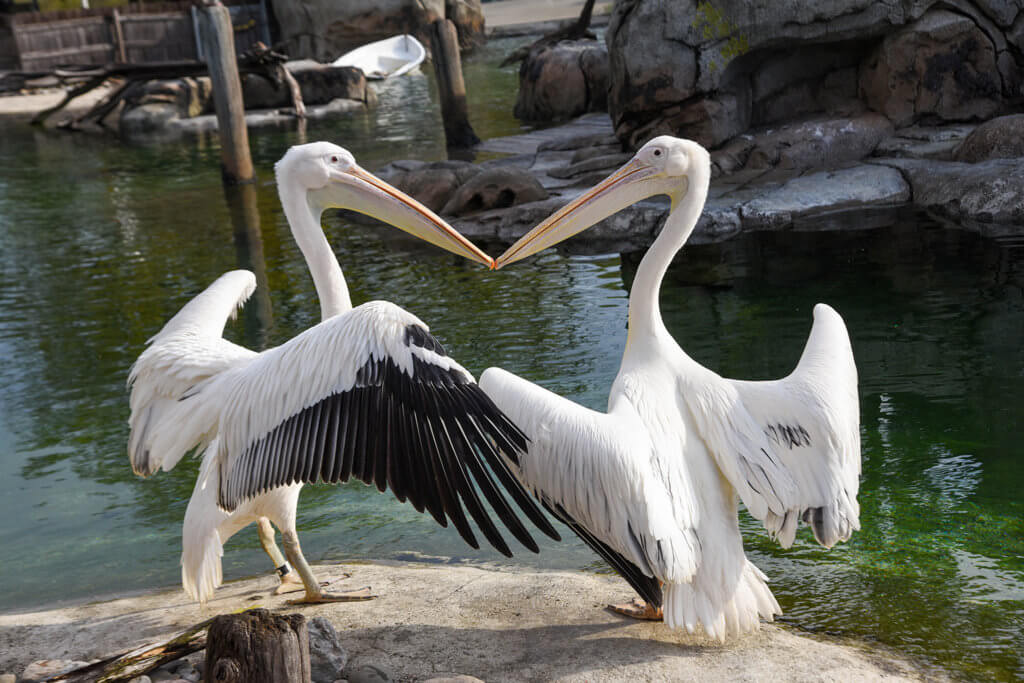Overview
“Where I live”
As a species, great white pelicans are migrators. Many populations spend winter in sub-Saharan Africa and migrate to parts of Europe and Central Asia to nest. Other populations remain in southern Africa year-round. Great white pelicans prefer to inhabit fresh or brackish waters of lakes, deltas, lagoons and marshes. Shallower waters best support their feeding habit.
“How I live there”
For some types of pelicans, like brown pelicans in the southeastern U.S, hunting is a solo affair. Great white pelicans, however, can be found hunting in groups. One cooperative technique that has been observed is a number of great white pelicans swimming in a circle, concentrating a group of fish and even forcing the fish into shallower water where the pelicans can more easily scoop them up. Sharing the catch, though, is not part of the bargain–the pelicans must still scramble to grab the fish that have been “herded,” and stealing fish from one another is not uncommon.
“Making my mark”
The pelican’s long bill pouch is certainly its most distinguishing feature. It is a much-expanded version of the gular pouch, which is found in some other birds, like cormorants. A gular pouch serves a thermoregulator for these birds, where a fluttering of the pouch releases excess heat from the blood passing through the skin.
As happens often in living things, an adaptation for one function may prove useful for another. The gular pouch of a pelican can serve double duty to expel excess body heat and as a fishing tool. While some fish eaters like penguins dive to catch their prey, the great white pelican’s hunting method is slightly different. These birds do not dive down under the water. Instead, they dip their heads into the water and scoop up a large pouch full of water and fish. In spite of what many cartoons suggest, a pelican does not carry or store water in its pouch. Although the pelican’s pouch can hold several gallons of water, a full pouch is only temporary while the bird is scooping fish from the water. When the pelican raises its head from the water, the pouch contracts, forcing the water out and trapping the fish inside.
“What threatens me”
The eggs of great white pelicans and juvenile pelicans may become a meal for a variety of predators including foxes, gulls, African sea eagles, frigate birds, and crows. In general, adult great white pelicans have only humans to fear.
The IUCN lists great white pelicans as Least Concern because their populations are so wide-ranging. But that does not mean that they do not face threats. As wetlands are drained for agriculture and aquaculture, great white pelicans lose access to nesting and feeding sites. Toxic pollutants like DDT that are used to control mosquitoes, can weaken pelican eggs, causing clutches to fail. Although DDT has been long banned in the United States, countries in Africa, and in Central and South America do still permit the use of the chemical.
Raising Young
Great white pelicans are considered monogamous for a breeding season, though the bond may continue across seasons. They nest in large colonies of a few hundred to thousands of pairs, with nests spaced apart just out of beak’s reach from one to another. Typically, a female will lay 1-3 eggs, and both the female and male share parenting duties. After about a month, a great white pelican chick hatches from its egg and is completely dependent on its parents for the first few weeks of life. Between the age of 9 and 10 weeks, a chick can run and flap its wings, and begins to fledge. The chick becomes independent at around 10 to 11 weeks of age.
Taxonomy
- Kingdom: Animalia
- Phylum: Chordata
- Subphylum: Vertebrata
- Class: Aves
- Order: Pelecaniformes
- Family: Pelecanidae
- Genera: Pelecanus
- Species: onocrotalus

